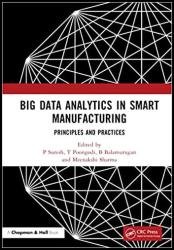 Название: Big Data Analytics in Smart Manufacturing: Principles and Practices
Название: Big Data Analytics in Smart Manufacturing: Principles and PracticesАвтор: P Suresh, T Poongodi, B Balamurugan
Издательство: CRC Press
Год: 2022
Страниц: 205
Язык: английский
Формат: pdf (true)
Размер: 10.16 MB
Smart manufacturing analytics explores recent trends and affords a roadmap to adopt Big Data analytics for promoting various applications that range from fault detection processes to predictive maintenance activities. Big Data analytics has significantly changed and automated the data exchange processes with advanced manufacturing technologies. To remain competitive in the industrial domain, new methodologies of manufacturing, innovation, procurement, and logistics are adopted. This book covers the novel research work contribution of various pervasive applications from the authors in smart manufacturing. The main objective of this book is to gather relevant contributions for analyzing historical perspectives focusing on technological revolutions. Furthermore, theoretical concepts, principles, and practices of Big Data analytics in smart manufacturing are investigated with the original research analysis of different case studies. The characteristics, benefits, impacts, challenges, and opportunities of Big Data in design and manufacturing are also presented.
Smart Manufacturing (SM) is an innovation-driven methodology that uses Internet-associated hardware to screen the creation cycle. The objective of SM is to recognize openings for robotizing activities and use information investigation to further develop fabricating execution. SM is a particular utilization of the Industrial Internet of Things (IIoT). Organizations include implanting sensors in assembling machines to gather information on their functional status and execution. Earlier, data were ordinarily kept in nearby information bases on individual gadgets and were utilized uniquely to survey the reason for gear disappointments after they happened. As SM turns out to be more normal, more machines become organized through the IoT, they will be better ready to speak with one another, possibly supporting more prominent degrees of mechanization.
Machine Learning (ML) discerned expanded utilization in commercial enterprise in the course of last many years. ML has stayed “depot” in each period of the item existence pattern: origination, plan, assembling, attribute, and preserve. With the expanded reception of the Industrial Internet of Things (IIoT), Industry 4.0, and Smart Assembling, significantly more information is being created. ML is turning into the main strategy that is utilized for anticipating and ordering the trouble taking care of issues inside the creation frameworks. ML utilizes expanded registering power and different programming for acquiring the significant data and information from the huge information, which are gathered from the climate, yet additionally has capacity to gain from that information by getting the fake/computational insight.
The supervised learning is AI method, indicated for a huge measure of information (preparing sets), which are applied to the frameworks where the right reaction is given by the educated master. In supervised learning, a framework is prepared with information that has been named. The unsupervised learning addresses the clever realizing where assessment of the activity isn’t reliant, given nor directed, in light of the fact that there is no learned master. In contrast to regulated learning, the unaided taking in doesn’t gain from marked information. Rather than that, it finds designs among the information.
Big Data possesses the traditional key traits such as volume, velocity, and variety, and added traits such as exhaustively, perseverance, indexicality, relationality, extensionality, and scalability make Big Data significant. Information System Management (ISM) in any organization consists of three major elements: hardware, software, and data. Hardware and software achieved their maturity level to some extent; however, the third element, data, is still struggling with challenges such as heterogeneity, scale, timeliness complexity, and privacy issues that are further exaggerated due to the continuous explosion of information. The adoption of Big Data approach creates value from data to make ISM more effective.
Скачать Big Data Analytics in Smart Manufacturing: Principles and Practices